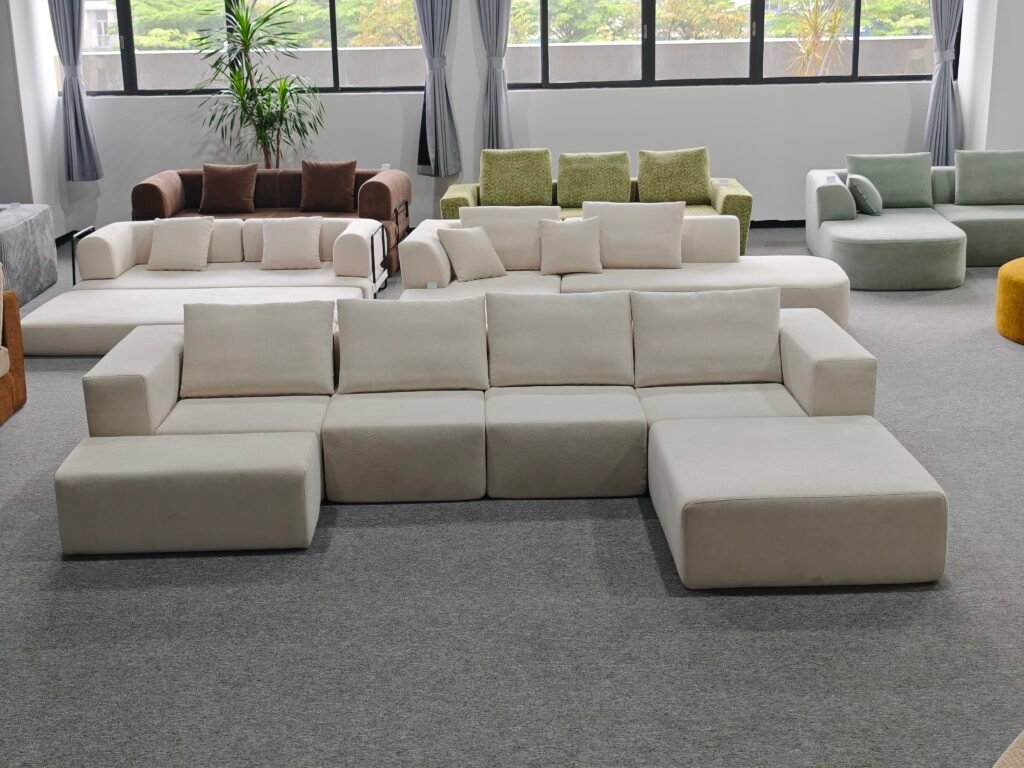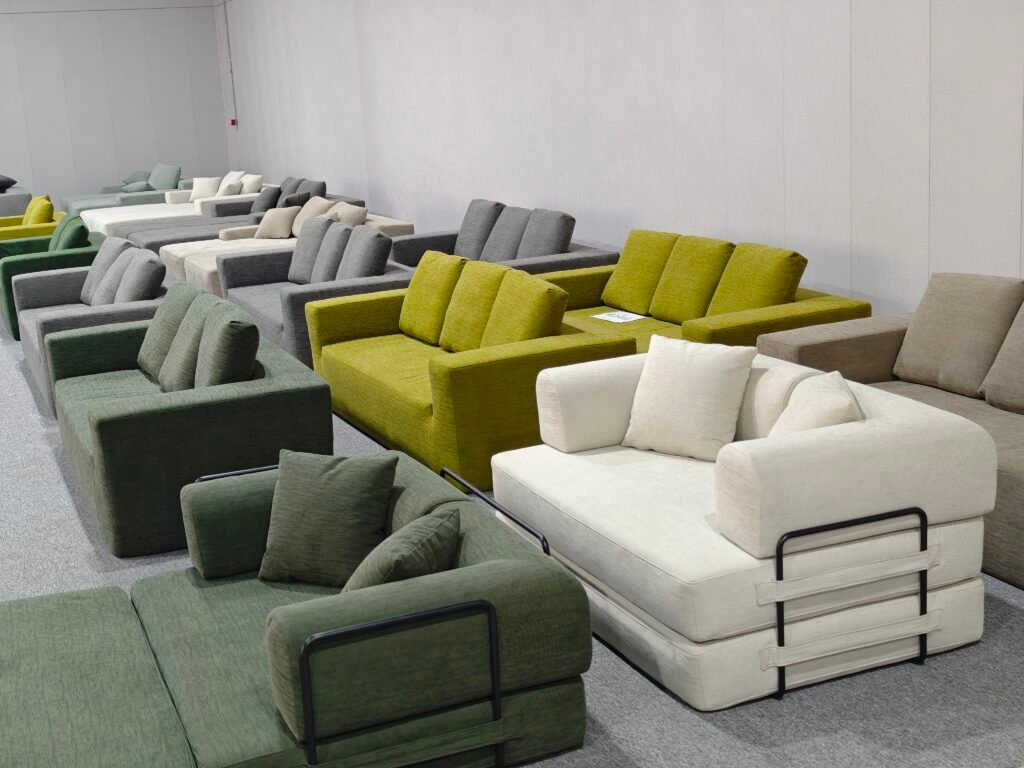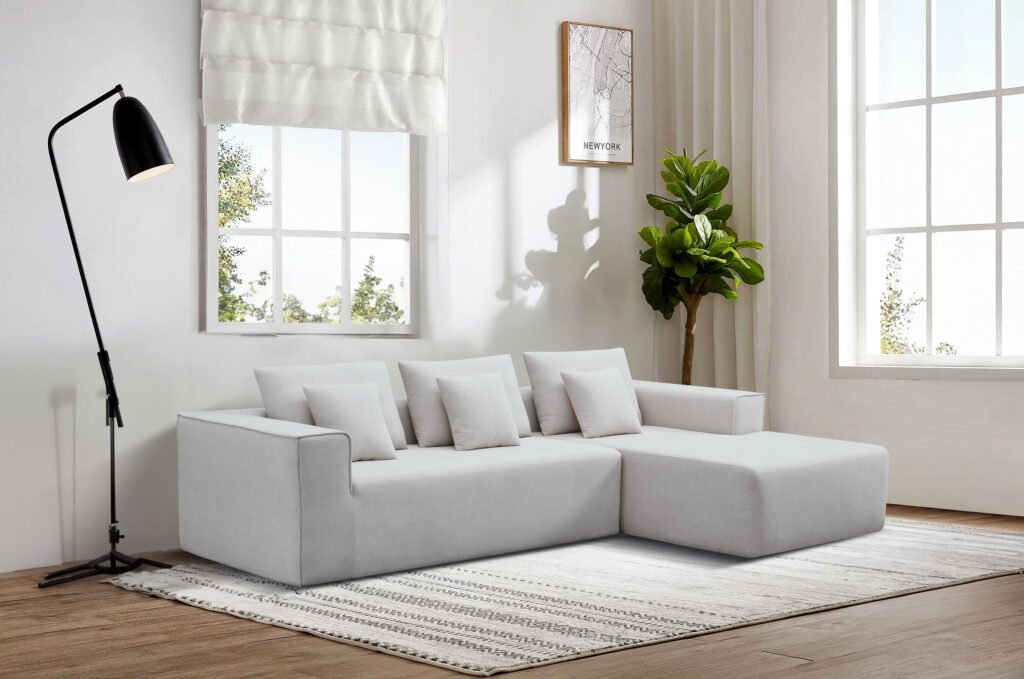The global furniture industry has undergone remarkable transformation during recent years, driven in large part by the emergence of compressed or vacuum-packed sofas. These innovative pieces revolutionize how furniture is designed, manufactured, transported, and ultimately enjoyed by consumers worldwide. Leading players like modular-sofas.com, a top-tier compressed sofa factory, have perfected sophisticated production techniques to deliver sofas that combine comfort, durability, and space-saving logistics.
Compressed sofas emerge from factory floors as fully assembled, vacuum-sealed products whose volume is dramatically reduced—often by more than sixty percent—enabling efficient shipping and reducing environmental footprints. Once unpacked, they quickly regain their original size and form, providing users with convenient, comfortable seating without traditional shipping hassles.
This in-depth article walks through the comprehensive journey of a compress sofa from raw material sourcing through design, assembly, compression, packaging, and final delivery. Understanding how these sofas are made sheds light on why compressed sofa factories like modular-sofas.com have become preferred partners for furniture brands, retailers, and distributors seeking quality, innovation, and sustainability.


Understanding the Compressed Sofa Concept
The notion of compressing a fully assembled sofa for shipment is a relatively recent innovation in furniture manufacturing. Unlike traditional furniture that ships bulky and fully formed, compressed sofas rely on materials such as high-resilience memory foam and specialized frames that can compress safely without damage. After factory compression and vacuum-sealing, the sofa is compact enough to fit into a much smaller shipping box.
The key technological breakthrough is in materials engineering and packaging. Sofas must be designed with components capable of withstanding mechanical stresses from compression and re-expansion without loss of comfort or structural integrity. This requires careful selection of foam types, upholstery textiles, spring systems, and frame materials.
By leveraging patented compression technologies and precise quality controls, trusted compressed sofa factories achieve the ideal balance of product longevity and logistics efficiency—which benefits everyone in the supply chain.
Design and Model Development
The manufacturing journey begins with comprehensive design and product development. Designers combine ergonomic principles with market trends and manufacturing feasibility to define new sofa models optimized for compression. Using advanced 3D CAD software, teams create digital renderings that simulate not only aesthetic dimensions but also behavior under cyclic compression.
Material selection is critical during this phase. To ensure compression resilience, designers specify CertiPUR-US certified foams combined with frames built from engineered hardwood or steel reinforcements. Upholstery options are designed to be flexible yet durable, including stain-resistant fabrics and leathers that tolerate compression without wrinkling or damage.
Prototype sofas are fabricated in limited quantities for rigorous testing. These models are analyzed for comfort, shape retention, compression tolerance, and recovery speed. Feedback loops between designers, engineers, and quality control refine the product toward optimal performance.
Additional features such as modular connectivity, hidden storage compartments, integrated USB ports, or removable covers are carefully incorporated during design to maximize both user convenience and manufacturing efficiency.
Sourcing Raw Materials and Quality Control
After finalizing designs, procurement teams source materials from certified suppliers. The focus on eco-friendly, standardized materials is paramount. Frames are mainly made from kiln-dried hardwoods like beech or birch or high-grade engineered woods treated for moisture resistance and dimensional stability. Steel frameworks are powder-coated to prevent corrosion.
Foams are generally multi-layered, with memory foam or high-density polyurethane providing comfort and rebound properties. CertiPUR-US certification ensures foams are free from harmful substances and meet strict environmental and performance criteria. Springs, if included, are individually pocketed to maintain noise-free, durable support.
Upholstery fabrics are selected for durability, colorfastness, and compliance with Oeko-Tex 100 or similar standards. Many factories offer a broad textile catalog including PU leather, microfiber, corduroy, cotton blends, and stain-resistant synthetics. All materials undergo strict inspection on arrival, verifying dimensions, tensile strength, dye consistency, and absence of defects.
The rigorous incoming quality inspections lay the foundation for consistent product reliability during manufacturing.
Frame Fabrication
The frame fabrication stage forms the sofa’s backbone and impacts its lifespan and comfort profoundly. Modern factories like modular-sofas.com employ CNC (Computer Numerical Control) cutting machines to mill wood or metal components with high precision and minimal waste.
Wooden components are cut according to detailed CAD specifications, ensuring exact alignment and strength where joints connect. Assembling frames involves expert craftsmanship where dowels, screws, locking joints, and specialized adhesives guarantee structural integrity. The frame is reinforced at concentrated stress points such as corners and armrests to endure repeated use and compression cycles.
Frames are then sanded to a smooth finish and treated with sealants or coatings designed to resist moisture or insect damage. For steel frames, powder coating provides durability and corrosion resistance.
Depending on the sofa style, frames may be constructed as single units or modular sections designed to join seamlessly to create larger configurations.


Spring System Installation
In models incorporating spring support, this phase adds crucial ergonomic benefits. Most premium compressed sofas use pocket spring systems that encase individual springs in fabric pockets, reducing noise and improving localized responsiveness.
Springs are strategically installed in seat cushions and sometimes backrests using staples or clips, evenly distributed across the frame. Underneath, supporting suspension layers like sinuous springs or elastic webbing provide additional bounce and durability.
This component is critical for comfort and load distribution, ensuring the foam layers above perform optimally without sagging or premature deformation.
Foam Cutting and Cushion Preparation
Once frames and springs are assembled, attention turns to the foam cushioning—the heart of the sofa’s comfort.
Automated CNC foam cutters trim blocks of high-density memory foam and polyurethane foam to precise shapes that match seat and backrest designs. Softer layers or gel-infused foams may be incorporated for enhanced ergonomics.
The cutting process accounts for thickness gradients, firmness zones, and ergonomic contours, ensuring optimal support where the body needs it most.
Foam layers are often laminated or adhesively bonded to improve structural cohesion during compression. Foam cushions are attached to the frame using industrial-grade adhesives, sewn straps, or Velcro fasteners to prevent shifting during packing or use.
Upholstery Preparation and Sewing
Simultaneously, upholstery preparation proceeds in dedicated areas outfitted with state-of-the-art cutting and sewing equipment.
Fabrics and leathers are cut into precise panels using computer-guided cutters that maximize yield and minimize waste. Stitching patterns include decorative elements, double reinforcements, piping, zippers for removable covers, and branding emblems.
The sewing process requires a balance between automated precision and artisanal skill to handle different materials’ characteristics, especially when working with genuine leather or stretch fabric blends.
Quality control monitors stitch density, seam alignment, tensile strength, and surface uniformity before upholstery materials proceed to assembly.
Sofa Assembly and Upholstery Application
During this stage, all components converge into the final sofa form. Skilled technicians fit upholstery covers tightly over foam cushions attached to the frame, carefully smoothing fabrics to avoid wrinkles or misalignments.
Decorative features such as tufting, buttons, and piped edges are applied by hand or machine to create an aesthetically pleasing finish. For modular sofas, joints and connectors are tested to guarantee a secure fit between sections.
Functional elements like removable zippered covers or integrated USB connectors are installed and checked. Final sofas are inspected for fit, finish, firmness, and compliance with design specifications before advancing to the compression stage.
Compression and Vacuum Packaging
This crucial stage defines the essence of compressed sofas.
Once the fully assembled sofa passes quality thresholds, it is fed into compression equipment designed to reduce its volume while preserving material integrity.
A machine applies hydraulic pressure or vacuum technology to mechanically compress the sofa—sometimes gradually folding the sofa before vacuum sealing it inside multi-layer polyethylene bags that prevent moisture ingress and protect against damage.
Typical compression ratios reach about 1:4 in volume reduction, although this varies by model and design.
Once compressed, sofas are packed into reinforced corrugated cartons, customized for maximum stackability and safe container loading.
Sophisticated vacuum sealing ensures airtight packaging, preventing expansion until the wrap is cut open by customers.
Multiple tests—including vacuum retention, compression rebound, and leak detection—validate packaging integrity.


Quality Assurance and Certification
At all stages from assembly through compression, the factory enforces rigorous quality checks.
Visual inspections for defects such as upholstery flaws or frame misalignments occur, alongside mechanical testing for compression resilience across thousands of cycles.
Certifications such as ISO 9001 management compliance, CertiPUR-US for foam safety, and European EN standards for furniture safety and fire retardancy underpin production credibility.
OEM and ODM customers often receive detailed inspection reports and sample approvals, ensuring customized models meet exact requirements.
Shipping Preparation and Logistics Efficiency
Once packaged, compressed sofas enter the logistics phase. Their dramatically reduced volume uniquely enables highly efficient packing in shipping containers.
A standard 40-foot high-cube container can hold approximately 400 to 450 compressed sofas, about four times the load achievable with traditional non-compressed sofas.
This efficiency reduces transportation costs, lowers carbon emissions, and shrinks warehouses’ spatial demands.
Modular-sofas.com provides flexible shipping terms including FOB, CIF, DDP, and supports dropshipping models accommodating small MOQ orders.
Their warehouse management integrates real-time inventory tracking and quality control to ensure swift order fulfillment.
Consumer Unpacking and Sofa Recovery
Upon arrival at retail locations or end customers’ homes, compressed sofas are unpacked and rebound.
The process involves removing exterior straps and cartons, carefully cutting open the vacuum-seal films, then laying the sofa flat to expand naturally.
Depending on foam density and room temperature, sofas restore their full shape and comfort within 24 to 72 hours.
Customers sometimes gently pat or reshape the sofa surfaces to accelerate air release and uniform expansion.
Detailed unpacking and care instructions often accompany products or are available online to optimize user experience.
Summary Table of the Production Process
| Production Stage | Description | Key Focus | Quality Measures & Checks |
|---|---|---|---|
| Design & Model Development | Ergonomic & aesthetic design, prototype testing | CAD modeling, material specification | Prototype validation, ergonomic testing |
| Material Procurement | Sourcing hardwood, certified foam, textiles, springs | Supplier certification & incoming QC | Dimensional accuracy, safety certificates |
| Frame Fabrication | CNC cutting, assembly, finishing | Structural strength & moisture resistance | Joint durability, finish smoothness |
| Spring Installation | Placement of pocket springs or coil springs | Noise reduction, load distribution | Compression testing, spring resilience |
| Foam Preparation | Multi-layer foam cutting, shaping, layering | Density and comfort gradients | Foam density & firmness testing |
| Upholstery Preparation | Cutting, stitching, assembly of fabric panels | Fit & finish, fabric durability | Seam strength, colorfastness |
| Sofa Assembly | Cover application, modular joining | Finish & detail accuracy | Visual & dimensional inspections |
| Compression & Vacuum Packaging | Mechanical vacuum compression, multi-layer sealing | Volume reduction, packaging integrity | Leak test, compression cycle durability |
| Quality Assurance | Multi-stage inspections & certifications | Defect detection, certification compliance | ISO, CertiPUR-US, EN etc. |
| Shipping Preparation | Carton packing, container loading optimization | Logistic efficiency, safe transport | Container packing ratio, damage prevention |
| Consumer Rebound | Unpacking, air expansion, sofa reshaping | User guidance, product recovery time | Customer satisfaction surveys |
Innovations Shaping the Future of Compressed Sofa Production
The compressed sofa market continues evolving at a rapid pace, driven by customer demand for convenience, sustainability, and adaptability.
Emerging innovations include biodegradable vacuum films to replace polyethylene, further reducing environmental impact. Smart foams with quicker recovery rates enhance unpacking times. Advanced AI and machine learning aid visual quality control, ensuring defect-free production lines.
Modular designs with interchangeable parts optimize shipping arrangements further and allow furniture configurations to evolve post-purchase.
Factories like modular-sofas.com continue investing in these improvements to lead the compressed sofa revolution with eco-conscious, consumer-focused solutions.
Final Thoughts
Compressed sofas exemplify an exciting fusion of materials science, industrial engineering, and supply chain innovation. The process from raw material acquisition through high-tech compression and global logistics shapes a modern furniture solution perfectly adapted to urban lifestyles and sustainable commerce.
Understanding the detailed production steps demystifies the technology behind the “sofa-in-a-box” and highlights why trusted compressed sofa factories such as modular-sofas.com represent key pillars in the international furniture industry.
For retailers, distributors, and brands, partnering with such factories ensures superior product quality, customization options, and logistical advantages that can drive profitability and customer loyalty alike.
If further detailed technical insights, case studies on compression technology, or supply chain optimizations related to compressed sofas would assist your business, expert guidance is available. Please feel free to inquire.